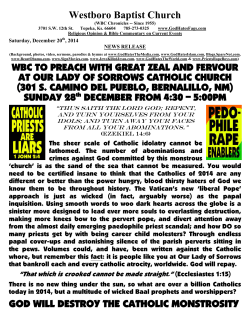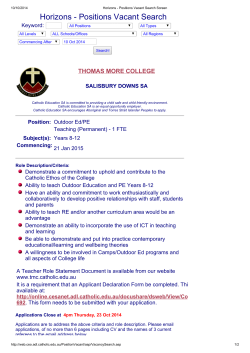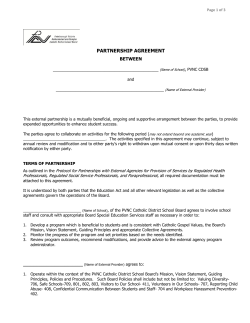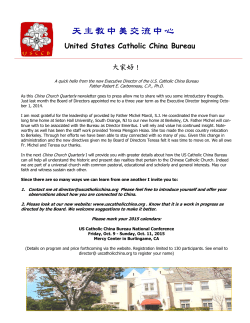
St Pancras Catholic Primary (opens new window)
Diocese of Arundel & Brighton – Lewes Deanery St Pancras Catholic Primary School DRAFT Admissions Policy and Procedures for admission in 2016 – 2017 St Pancras Catholic Primary School in Lewes is a voluntary aided school in the Diocese of Arundel & Brighton. The school was founded by and is part of the Catholic Church and is in Trusteeship of the Diocese. The school is conducted as a Catholic school in accordance with canon law, the teachings of the Catholic Church and the Trust Deed of the Diocese of Arundel & Brighton. It seeks at all times to be a witness to Jesus Christ. The school offers a Catholic education. The governors expect that parents applying for places for their children will accept and uphold the Catholic character and ethos of the school. The school was set up primarily to serve the Catholic community in Lewes. The relevant parish map can be viewed at the school by arrangement. Although Catholic children have priority of admission, the Governing Body also welcomes applications from those of other denominations and faiths and those with no faith who support the religious ethos of the school. Having consulted with the Diocese, Local Authority, other admission authorities and other relevant groups, the Governors intend to admit into the reception class, in September 2016, up to 20 pupils without reference to ability or aptitude. Oversubscription Criteria: Where the number of applications for admission exceeds 20, and after the admission of pupils with Education, Health and Care (EHC) Plans where the school is named on the Plan, the Governors will offer places using the following criteria in the order stated:1. Baptised Catholic looked after children or previously looked after children (see note a)). 2. Baptised Catholic children. Evidence of Baptism will be required (see note b)). 3. Catechumens; Children baptised in another Christian denomination and whose parent or carer, who for at least 6 months prior to the closing date for applications, has been enrolled on a programme of preparation to come into full Communion with the Catholic Church; ‘non-baptised’ children who together with a non-baptised parent or carer, who for at least 6 months prior to the closing date for applications has been enrolled on a programme of preparation to come into full Communion with the Catholic Church. A letter of confirmation from a priest involved in the instruction will be required (see note c)). 4. Other looked after children or previously looked after children (see note a)). 5. Children of families who are members of other Christian denominations that are part of Churches Together in England. Evidence of Baptism (or dedication) provided by a priest or minister of a designated place of worship will be required. 6. Any other children. Priority within the Oversubscription Criteria (tiebreakers): The governors will apply the following cascading order of priorities within any of the above criteria when applications exceed the number of places available and it is necessary to decide between applications through a priority ranking: i. Exceptional social or medical need which make the school particularly suitable for the child in question. Strong and relevant evidence must be provided by an appropriate professional authority (e.g. qualified medical practitioner, education welfare officer, social worker or priest) (see note d)). ii. A sibling on the school roll at the time of admission. Evidence of the relationship may be required (see note e). iii. Distance from home (the address at which the child resides) to the school (closest proximity receives highest priority) (see note f)). Evidence of residence may be required. In the admissions round for 2015/2016 of the children admitted were Catholics. _____________________________________________________________________________________ Admission Procedure The governing body of St Pancras Catholic Primary School is responsible for determining the admission arrangements of the school, including the priority of admissions to the school when the school is oversubscribed. When the application deadline has closed, the Local Authority (LA) provides to the school a list of all applicants who have applied to the school. The school will then rank the applications in strict accordance with its published admission arrangements and provide the LA with the ranked list. The LA is responsible for coordinating the allocation of places in its area, offering individual places to parents on behalf of the school governors on the common offer date of 16 April 2016. To apply for a place at this school, you should complete and return the following two forms: 1. The Common Application Form (CAF) All applications for places must be made on the Common Application Form which is available either from the Local Authority (where the parent lives) or on that Local Authority’s website. For a valid application, the CAF must be returned either online or in the paper form by 15 January 2016. 2. The school’s Supplementary Information Form (SIF). This is available from the school and the school website and allows the governors to put all applicants in order of priority for admission in line with the published admission policy. Please note that while completion of the SIF is not mandatory, if a completed SIF is not received, the governing body will only be able to consider the application based on information provided to the Local Authority on the CAF. To put this in practical terms, if a completed SIF is not received, it is likely that governors will only be able to rank the application within the last i.e. ‘Any other children’ criterion. The completed SIF must be returned to the school office by 15 January 2016. You are advised to keep copies of the forms for your records, whether completed online/ on paper. If you need help making an application, please contact Ms Parratt in the school office on 01273 473017. Late Applications All pieces of paperwork are required on or before the published closing dates referenced above. Late applications (those where it is reasonable that a parent could have submitted an application by the closing date) will only be processed when those applications have been dealt with. Any late applications will be considered by the Governors' Admissions Committee, in the event of there being any available places using the above criteria. If all places have been filled, parents will be offered the opportunity of placing their child’s name on the waiting list. This does not prevent parents from exercising their right to appeal against the decision not to offer a place. Waiting Lists If the school is oversubscribed, parents/carers of children who have not been offered a place at the school may ask for their child’s name to be placed on a waiting list. The waiting list will be operated using the same admissions criteria listed above. Placing a child’s name on the waiting list does not guarantee that a place will become available. This does not prevent parents/carers from exercising their right to appeal 2 against the decision not to offer a place. The waiting list will be maintained for one academic year. The waiting list will be ranked in line with the oversubscription criteria each time a child is added to the list. Appeals Parents/carers whose applications for places are unsuccessful may appeal to an Independent Appeal Panel set up in accordance with sections 88 and 94 of the School Standards and Framework Act 1998. Appeals must be made in writing and must set out the reasons on which the appeal is made. Appeals should be made to the Admissions Appeal Clerk at the school address. Parents/carers have the right to make oral representations to the Appeal Panel. Please note: the decision of the Appeal panel is final and the school must keep to it. If your appeal is unsuccessful, you cannot appeal for this school again in the same academic year, unless there is a significant change in your circumstances. But you can, of course, stay on the waiting list for this school. In Year Admissions The oversubscription criteria in this admission policy will also apply to applications made outside the normal age of entry to primary education (Reception Year) i.e. in succeeding years or during the academic year. Please ensure that you contact the school directly when making an In-Year application. Offer of a Place Allocation letters are posted by the Local Authority on 16 April 2016. If you applied on-line you can view your school offer online on this date. Visiting the School We encourage parents/carers to visit our school in order to find out more about how we work and the education we offer. Parents/carers are welcome to arrange a visit by contacting the school office. However, such visits do not form part of the process of deciding which children are to be offered a place at the school. Giving us the wrong information If a parent/carer is found to have supplied false or incorrect information to gain a place at this school, the governing body reserves the right to withdraw any offer of a place even if the child has already started school. An example of false or incorrect information would be the use of an address that is not the child’s normal residence. _________________________________________________________________________________ Notes (these form part of the admission arrangements): a) ‘Looked after children’ are children who are registered as being in the care of the Local Authority or provided with accommodation by a Local Authority in accordance with Section 22 of the Children Act 1989(a) e.g. fostered or living in a children’s home, at the time an application for a school is made. ‘Previously looked after children’ means such children who have previously been in the care of a Local Authority or provided with accommodation by a Local Authority in accordance with Section 22 of the Children Act 1989(a) and who have left that care through adoption, a ‘child arrangement order’ (in accordance with Section 8 of the Children Act 1989 as amended by the Children and Families Act 2014) or special guardianship order (in accordance with Section 14A of the Children Act 1989). b) ‘Baptised Catholic’ describes a member whose Church of Baptism is ‘in communion with the See of Rome’. The Catholic Church comprises the Latin Rite (Roman Catholics) and the Eastern or Oriental Rite 3 (composed of Catholic (Uniate) Churches - see below). This will be evidenced by a certificate of Baptism in a Catholic Church or certificate of reception into full communion with the Catholic Church. Eastern or Oriental Rite Catholic Churches in Full Communion with Rome ALEXANDRIAN Coptic, Ethiopian (Gheez) ANTIOCHIAN Malankrese, Maronite, Syrian ARMENIAN Armenian CHALDEAN (EAST SYRIAN) Chaldean, Syro-Malabar CONSTANTINOPOLITAN (BYZANTINE) Albanian, Belarusian, Bulgarian, Georgian, Greek (Hellenic), Greek-Melkite, Hungarian, Italo-Albanian, Krizevci, Macedonian, Romanian, Russian, Ruthenian, Slovak (Greek), Ukrainian (Greek) Notes: 1. Eastern Orthodox Churches, including the Coptic Orthodox, Greek Orthodox and Russian Orthodox Churches, are NOT in full communion with the See of Rome. 2. ‘Ordinariates’ are members of the Latin Rite. 3. Anglicans describing themselves as ‘Anglo Catholics’, are members of the Anglican Communion and therefore not in communion with the Holy See. Please refer any queries to the Catholic Schools Service. c) Catechumen describes someone formally admitted to the order of catechumens as part of preparation for the reception of the sacrament of baptism in the Catholic Church. d) Exceptional medical need: If the child has a serious medical condition/disability such that the parent feels the child must go to this particular school, this must be specified on the Supplementary Information Form. Governors can only consider applications under this category if supporting evidence is attached, e.g. a letter from a registered health professional, setting out the particular reasons why this school is the most suitable and the difficulties that would be caused if the child attended another school. Governors will make their decision based on the medical evidence provided by the child’s medical consultants. Governors will consult the LA’s medical advisers and only agree to a priority placement if the medical advisers consider it necessary for the child to attend this school. Governors will also take into account any information on exceptional medical need that is provided by the Local Authority from the Common Application Form. Exceptional social need: If parents feel there are sensitive, individual and serious family circumstances, perhaps involving the support services (e.g. social care) these may be considered at the time of the application for a school place. This will need to be specified on the Supplementary Information Form and evidence provided, e.g. a report from social services or from a priest detailing why this school is the most appropriate placement for the child given the circumstances of the case. Governors will also take into account any information on exceptional social need that is provided by the Local Authority from the Common Application Form. e) Siblings: For admission to this school, a sibling is defined as a brother or sister (i.e. another child of the same parents, whether living at the same address or not), or a half-brother/ half-sister or a stepbrother/ step-sister or an adoptive or foster brother/ sister, living at the same address. A child will be given sibling priority if they have a sibling at the school at the time of the child’s admission. Governors will also take into account any information on siblings that is provided by the Local Authority from the Common Application Form. f) Distance: Distance will be measured on the basis of the straight line distance from home to school using the East Sussex Geographical Information System (GIS). Distances are measured from the child’s home to the nearest gate used by pupils at the school. In the event that applicants cannot be prioritised using the tiebreaker because the distance measurements are the same, the Local Authority will use random allocation to decide which children will be offered the remaining places. This will be done electronically using the Local Authority’s admissions software. A child’s home address is considered to be a residential property that is the child’s only/main residence and not an address that is sometimes used due to certain domestic/special arrangements. The address must be the pupil’s home address at the closing date for applications and which is either owned by the child’s parent, parents, or guardian OR leased or rented by the child’s parent, parents or guardian under a lease or written rental agreement. If parents live separately but share responsibility for the 4 child, and the child lives at two different addresses during the week, the ‘home address’ will be regarded as the one at which the child sleeps for the majority of weekday nights. If two addresses are provided, the Local Authority will decide which address should be used as the main residence for the purpose of processing the application as they only accept one current address. Parents/Carers must notify the school about any address changes during the application deadlines to ensure all applications are treated in the same way. A block of flats has a single address point reference, so applicants living in the same block will be regarded as living the same distance away from the school. In the unlikely event that two or more children live in the same block and in all other ways have equal eligibility for the last available place, the names will be issued a number and drawn randomly to decide which child receives the place. g) Parents/carers/family members: The terms ‘parent’ or ‘carer’ are used for all persons who legally have responsibility for the child. h) Starting School at Age 4+: Although children are of compulsory school age from the beginning of the term following their fifth birthday, schools must provide for the admission of all children in the September following their fourth birthday. Parents can choose for their child to start school on a parttime or full-time basis in the September following their fourth birthday. It is recommended that any decision about whether a child attends part-time or full-time is reached in discussion with the headteacher (and, if appropriate, staff at the child’s pre-school setting). Parents may also request that their child’s entry be deferred until later in the same school year. The place allocated is then held and is not available to be offered to another child. If parents do not want their child to start school in the September following their fourth birthday, they should talk to the headteacher (and, if appropriate, the head of the pre-school playgroup/ nursery setting) about when the place is taken up. Places cannot be deferred beyond the beginning of the term after the child’s fifth birthday, nor beyond the school year for which the original application was accepted. Therefore, if your child is four years old between 1 April and 31 August 2016 the latest date the offer of a place may be deferred would be the start of the summer term 2016. i) Infant Class sizes: Current infant class legislation spells out that infant classes (Reception, Year 1 and Year 2) must not contain more than 30 pupils with a single school teacher. Additional children may only be admitted under very limited exceptional circumstances. One of these exceptions is where it is a child whose twin or sibling from a multiple birth is allocated the final place in an infant class. This school will allow this exception wherever logistically possible. j) Children with Education, Health and Care (EHC) Plans naming the school on the Plan: These children are admitted under a separate procedure. Reminder : Have you remembered to complete: 1) the Local Authority’s Common Application Form (CAF) and 2) the School’s Supplementary Information Form (SIF)? For any further information or to make an appointment to visit the school, please contact Ms Parratt in the school office: St Pancras Catholic Primary School De Montfort Road Lewes East Sussex BN7 1SR Tel 01273 473017 Email: office@st-pancras.e-sussex.sch.uk 5
© Copyright 2025









